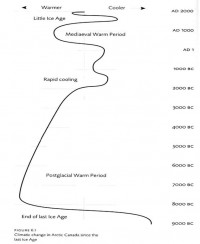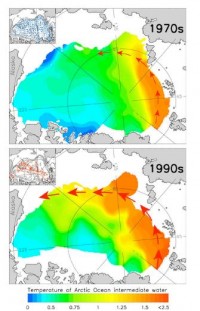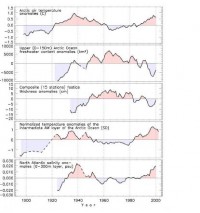By Syun-Ichi Akasofu, International Arctic Research Center
An almost linear global temperature increase of about 0.5C/100 years (~1F/100 years) seems to have started at least one hundred years before 1946, when manmade CO2 in the atmosphere began to increase rapidly. This value of 0.5C/100 years may be compared with what the International Panel on Climate Change (IPCC) scientists consider to be the manmade greenhouse effect of 0.6C/100 years. This 100-year long linear warming trend is likely to be a natural change.
One possible cause of the linear increase may be Earth’s continuing recovery from the Little Ice Age (1400-1800). This trend (0.5C/100 years) should be subtracted from the temperature data during the last 100 years when estimating the manmade contribution to the present global warming trend. As a result, there is a possibility that only a small fraction of the present warming trend is attributable to the greenhouse effect resulting from human activities. Note that both glaciers and sea ice in the Arctic Ocean that had developed during the Little Ice Age began to recede after 1800 and are still receding; their recession is not a recent phenomenon. One lesson here is that it is not possible to study climate change without long-term data. In fact, one way to learn about natural changes is to examine climate change before the greenhouse effect of CO2 became significant in about 1946.

Climate change in arctic Canada after the last major ice age (McGhee, 1941). Larger image here.
The present rapid retreat of sea ice in the Arctic Ocean, particularly in 2007, is caused by the inflow of the warm North Atlantic water into the Arctic Ocean and the effects of winds. Figure below shows the results of the ocean monitoring effort by an international group, led by the International Arctic Research Center.

Inflow of warm North Atlantic water into the Arctic Ocean (Polyakov, 2006). Larger image here.
This warm water is melting sea ice from the bottom. The resulting thin ice tends to break up easily by stormy water and is easily forced to flow by winds; nothing can move sea ice (which covers an area of the United States) in the Arctic Ocean, if it is a single plate. This was exactly what happened in the fall of 2007, resulting in a large recession of sea ice toward the Canadian side (some expected further shrinking in 2008, but that is unlikely). It was shown by Polyakov (2006) that this inflow is a quasi-periodic phenomenon.

Air temperature and various conditions of the Arctic Ocean between 1895 and 2000 (Polyakov et al., 2008). Larger image here.
The Earth as a whole experienced a relatively cold period, the Little Ice Age (LIA), between 1400 and 1800. The Earth is still recovering from the LIA. There is nothing unusual or abnormal about the present global warming trend and temperature. There were a number of periods when the temperature was higher than the present.The predicted temperature in 2100 by the IPCC is not reliable, because the present GCMs are adjusted or “tuned” to result in the 0.6C/100 years increase by hypothesizing the CO2 effect. Read this very detailed note here.


